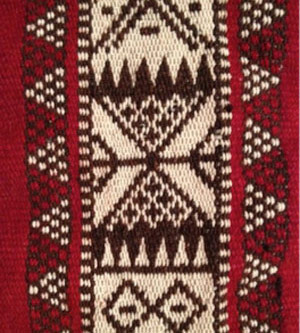Technique
The term "Al Sadu" in Arabic means weaving done in a horizontal manner, using a ground loom to create a tightly woven, durable fabric from natural fibers found in the surrounding environment.
Application
The quality of each woven item depends on the skill and expertise of the weaver, as well as the quality of the yarn used. Typically, older Bedouin women are the primary bearers of this tradition and play a crucial role in passing on their knowledge and skills to others. This is often done through household instruction, but also through classes or workshops offered by organizations. Although Al Sadu items are sometimes created for sale or personal interest, they primarily serve as a symbol of tradition and culture and highlight the importance of women in Bedouin society.
Meaning & Symbols
The patterns in Bedouin weaving are influenced by the desert environment and consist of simple, pure geometric designs that flow in a rhythmic and symmetrical manner. Weavers also incorporate bright colors such as reds and oranges to enliven their surroundings.



One thought on “Al Sadu”
Comments are closed.